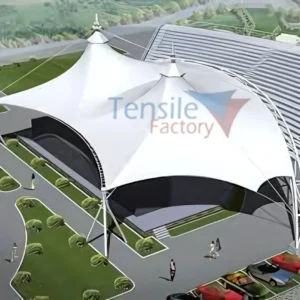In modern architecture and construction, tensile structures have become a popular choice for creating lightweight, aesthetically pleasing, and durable roofing and shading solutions. From sports stadiums to shopping malls, airports, walkways, and even outdoor cafés, tensile structures are being widely used to combine functionality with elegance.
This blog explores how tensile structures work, their engineering principles, and the different types of tensile structures that are commonly used around the world.
Tensile Structures
The history of tensile structures began with ancient tents, where cloth or leather was stretched over ropes and poles to create a shelter. Over time, they began to be used in military camps and fairs. As factories or industries grew, when steel and new fabrics were invented, tensile structures became even stronger and larger. In the 20th century, architect Frei Otto popularized it worldwide and today they are widely seen in stadiums, airports, malls and exhibition halls. Now tensile structures made from modern materials such as PVC, PTFE and ETFE are lightweight, durable and beautiful as well as environmentally friendly and energy efficient.
How Do Tensile Structures Work?
The working principle of tensile structures lies in tension and equilibrium. Here’s a simplified breakdown:
- Membrane or Fabric Material: A tensile fabric (commonly PVC-coated polyester, PTFE-coated fiberglass, or ETFE foil) is stretched across a framework.
- Supporting Elements: Steel cables, masts, or frames hold the membrane in place. These supports are carefully engineered to maintain tension.
- Load Distribution: Instead of resisting loads by mass (like concrete), tensile structures transfer loads through tensioned surfaces and supporting cables. Wind, snow, or live loads are evenly distributed across the surface.
- Anchoring System: The fabric is fixed to the ground or surrounding structure with anchoring systems that keep the membrane stretched at all times.
- Shape and Curvature: The strength of a tensile structure is derived from its form. Curved geometries like hyperbolic paraboloids, cones, and arches help balance tension and maintain structural integrity.
Advantages of Tensile Structures
Tensile structures are widely used because of their multiple benefits:
- Lightweight Construction – Less material required compared to traditional buildings.
- Large Span Coverage – Can cover vast areas without internal supports.
- Architectural Aesthetics – Sleek, futuristic, and visually appealing.
- Flexibility – Easy to design into different shapes and patterns.
- Durability – Resistant to UV rays, weather conditions, and fire (depending on fabric).
- Quick Installation – Pre-fabricated components allow faster assembly.
Applications of Tensile Structures
You will find tensile structures in a wide range of applications, including:
- Stadiums and sports arenas
- Airport terminals and walkways
- Outdoor amphitheaters
- Shopping malls and commercial complexes
- Car parking shades
- Cafés, restaurants, and resorts
- Exhibition spaces and trade fairs
- Public parks and recreational areas
Different Types of Tensile Structures:
1. Conical Tensile Structure: A conical tensile structure resembles a cone, where the fabric is stretched between a circular base and a central high point.
Features:
- Iconic tent-like appearance
- Provides shade and water runoff
- Ideal for small to medium-sized areas
Applications: Car parking, outdoor seating, kiosks, and open-air restaurants.
2. Hypar (Hyperbolic Paraboloid) Tensile Structure: This is one of the most common and visually striking tensile forms. The fabric is stretched between four points at varying heights, creating a saddle-like shape.
Features:
- Strong double curvature
- Elegant and modern look
- Excellent wind resistance
Applications: Walkway covers, exhibition pavilions, and entrance canopies.
3. Barrel Vault Tensile Structure: The barrel vault design is shaped like a half-cylinder or arch, formed by stretching fabric across curved frames.
Features:
- Provides a continuous covered space
- Highly durable and weather-resistant
- Allows large spans without internal supports
Applications: Industrial warehouses, sports facilities, and large public halls.
4. Dome Tensile Structure: As the name suggests, dome tensile structures form a dome-like shape with fabric stretched over a circular or polygonal frame.
Features:
- Creates a spacious, enclosed atmosphere
- Excellent strength and stability
- Provides all-weather protection
Applications: Amphitheaters, event venues, exhibition halls.
5. Frame-Supported Tensile Structure: Here, fabric membranes are stretched over a rigid steel or aluminum frame, providing stability and shape.
Features:
- More control over shape and dimensions
- Can be combined with glass or steel facades
- Suitable for semi-permanent structures
Applications: Mall atriums, resorts, and office complexes.
6. Suspended Tensile Structures: These structures rely on steel cables suspended between supports, with fabric draped and tensioned between them.
Features:
- Lightweight and elegant
- Minimal use of material
- Strong in handling dynamic loads
Applications: Stadium roofs, footbridges, and large outdoor venues.
7. ETFE Foil Structures: A more advanced form of tensile architecture, ETFE (Ethylene Tetrafluoroethylene) is a transparent polymer used in cushion-like membranes.
Features:
- Lightweight but stronger than glass
- Allows maximum natural light
- Excellent thermal insulation
Applications: Airport terminals, botanical gardens, and stadiums (e.g., Allianz Arena in Germany).
In conclusion, from ancient tents to modern stadiums and airports, tensile structures have come a long way. Being lightweight, attractive, durable, and energy-efficient, these have become an important choice in the world of architecture and construction today. With the help of modern materials and engineering techniques, these not only provide beauty and functionality but will become even more popular as eco-friendly and smart structures in the future. Today tensile structures are becoming popular with a variety of designs and advanced features. Whether it is a sports stadium, airport terminal, or a small cafe shed, tensile structures are also widely used; they bring functionality and beauty together.





